- Home
- C. C. Humphreys
Blood Ties
Blood Ties Read online
Critical acclaim for C.C. Humphreys
Blood Ties
‘With The French Executioner Humphreys established himself as a quality purveyor of historical detail and vigorous action … This unusual storyline is dispatched with consummate skill, and the conflict between father and son has an intelligence and sophistication that transcends the narrative’
Good Book Guide
‘C.C. Humphreys excels as ever in the throat-in-mouth action and knows instinctively how to keep a reader pasted to the page … This novel shows a writer reaching ever upwards and I can’t wait for Humphreys’ next novel. If you like Bernard Cornwell’s Grail Quest series, you’ll love The French Executioner and Blood Ties. To my mind, Cornwell is good, but Humphreys is better’
Sally Zigmond, Historical Novels Review
The French Executioner
‘Falling somewhere between the novels of Bernard Cornwell and Wilbur Smith, C.C. Humphreys has fashioned a rollicking good yarn that keeps the pages turning from start to finish’
John Daly, Irish Examiner
‘… how he fulfills his mission is told with enormous zest in this splendid, rip-roaring story … a fine addition to the tradition of swashbuckling costume romance of which Robert Louis Stevenson is the incomparable master’
George Patrick, Hamilton Examiner
‘Don’t miss this wonderful saga of magic and heroism … if you can find a first impression, hoard it and wait till it rises in value like a first edition of Lord of the Rings. This is as good. For sheer pleasure I’ve read nothing to match it all year’
Russell James, Crime Time magazine
For my parents, Peter and Ingegerd, and the stories they told me
BLOOD TIES
C.C. HUMPHREYS
Contents
Cover
Praise
Dedication
Title Page
Author’s Note
Part One: Old World
Prologue: The Exhumation
One: Siena
Two: Inquisition
Three: Hands of the Healer
Four: Flight
Five: Royal Prisoner
Six: Brother Silence
Seven: The Ruin of All Hope
Eight: Rune Cast
Nine: Crossroads
Ten: London
Eleven: Reunions
Twelve: Into The Belly of the Beast
Thirteen: Tartarus
Fourteen: Sins of the Father
Fifteen: Endgame
Sixteen: The Hostage
Seventeen: The Grey Wolf and the Bear
Eighteen: Death on the Shore
Part Two: New World
One: Homecoming
Two: Fire Stick
Three: White Cedar
Four: Deer Hunt
Five: Witch Hunt
Six: Trials
Seven: Sacrifice at Sunrise
Eight: Andac-Wanda
Nine: Ghosts
Ten: Death Song
Epilogue
Historical Note
About the Author
Also By C.C. Humphreys
Copyright
AUTHOR’S NOTE
Whereas the genesis of my first novel, The French Executioner, came in a blinding flash – the swordsman, Jean Rombaud, taking Anne Boleyn’s six-fingered hand as well as her head – the idea for this second arrived more stealthily. I knew I wanted to spend more time with the characters I’d already created yet the book had to stand alone. I enjoy writing action-filled adventures, but felt that this story should be more intimate, and explore further my characters’ inner conflicts. The idea of a war within the family came then – father versus son, brother against sister, mother against daughter. But I still needed some historical ‘pegs’ to hang my fictional story upon.
When I began writing historical fiction, I thought research was about getting the details right, and indeed there is huge satisfaction in accurately describing the past. But what research really does is act as a stimulus. I rediscovered the old truth that fact is stranger than fiction time and again. One fact unearthed is the very seedbed of creation. And so often that fact, that date, that place, can seem an almost miraculous thing.
Some examples – I knew I wanted to involve the new as well as the old generation from the previous novel. Since I’d left my characters in the epilogue, happy and content near Siena in 1546, I wondered what was happening there, say, in 1555, when the children would be grown yet their parents not too old to have adventures. I discovered that war had once more ravaged the land and that Siena endured a terrible siege … that ended on 17 April 1555.
I then had the idea of transferring the threat against Anne Boleyn to her daughter. Schoolboy history told me that Elizabeth was in great danger throughout the reign of her sister – Bloody Mary. Further research told me that Elizabeth was summoned to Hampton Court, still under arrest … on 21 April 1555.
Across a continent, four days apart! My characters, fictional and real, in crisis. With such symmetry of dates, I felt blessed. The rest was almost easy.
Almost. There was one other aspect I felt compelled to include. Though raised in London, I was born in Canada, have often been drawn back to its stunning forests, mountains and rivers. How could I honour these two halves of myself, the Englishman and the North American? What was going on in Canada at the time that could link it to these events in Europe? I researched. I discovered, again, more amazing things than I could ever invent. Especially that in 1536, the year that Anne Boleyn was executed, a Breton explorer, Jacques Cartier made the first of three voyages to the St Lawrence. He took hostages back to France. Applying the ‘what if?’ of the fiction writer I wondered if a baby hostage could have survived. If so that young man would have been eighteen in 1555. The same age as Jean Rombaud’s daughter, Anne.
I had my link from the Old World to the New. Hence the second half of this book. My research then disgorged facts of the native cultures of the time that almost dictated my story thereafter. Not least that the tribe Cartier encountered who, later, were dubbed ‘Huron’ by the Europeans, were driven away by their blood enemies, one tribe of the nations later known as the Iroquois …
… sometime in the 1550s.
I had my overall story and more facts gave me wonderful set pieces and characters. Several books stimulated. The Huron: Farmers of the North by Bruce G. Trigger, was a source of riches, as was The League of the Iroquois by Lewis Henry Morgan. (Written in 1851, I found a second-hand copy under strange circumstances one day while walking down the Finchley Road. It was in the window of a tatty shop that seemed to have mainly soft porn videos, with a very odd owner who tried to convince me that the Ark of the Covenant was a giant crystal CD player. Both owner and shop had disappeared when I looked a week later. Spooky!) I’ve taken as my Native models the Tahontaenrat, the Huron tribe that could have been the one driven out of the St Lawrence in 1555. I based their conquerors on their old enemies, the Seneca, an Iroquois nation who could have expelled them. My study of their customs and language – both tribes spoke versions of Iroquoian –are mainly drawn from written sources begun some hundred years later. But these societies, by all accounts, hadn’t changed much in the previous centuries. They had their clan groupings, their councils, their ways of hunting and war, even their lacrosse. They had evolved advanced social structures and had no need to change. Until the Europeans came.
The siege of Siena is brilliantly analysed in Simon Pepper and Nicholas Adams’s Firearms and Fortifications – Military Architecture and Siege Warfare in Sixteenth-Century Siena. The Tower of London website was a great help as was a book my brother sent me that we’d had in the family for ages: The Tower of London by W. H. Ainsworth. This was given to my brother by Great Aunt Ethel whose ancestor,
and therefore mine, Sir Henry Bedingfield, was Princess Elizabeth’s gaoler at Woodstock. (I desperately tried to get this relative into the novel as some heroic swashbuckler but he just wouldn’t fit!) A retired Jesuit, Fr. Richard Foley, helped me with my Latin.
I spent a wonderful day with John Moses, a Native History Researcher at the fantastic Canadian Museum of Civilisation in Hull, Quebec. Part Iroquois himself, he talked brilliantly and had photocopied many articles that proved invaluable. Best of all, he gave me white gloves, then led me into the stacks of artefacts that the public never see. Here I hefted genuine Iroquois war clubs; one, from the early seventeenth century, especially captured me, becoming the basis for the duel fought in Part Two. I will never forget the feeling as I swung it through the air. That sort of research is beyond price – especially to a fight choreographer.
The main difficulty of writing about native affairs is the fear of stereotyping peoples every bit as complex as one’s own without the innate understanding one has from growing up in their culture. There is also a great deal of controversy about certain points – for example, scalping and who actually began it. After much pondering I decided to include it as part of their way of life, while being fully prepared to admit that they may well have been taught it by early Europeans. What I was determined to avoid was the Hollywood trap of depicting all natives as ‘Noble Savages’.
There is so much to admire in the proto-Huron and Iroquois societies. The richness of their myths and the sophistication of their psychology, the respect they accorded each individual. The way Huron children were treated as just other, smaller, humans and never struck, which the Jesuits could hardly believe. The honour given to women and their opinions, particularly amongst the Iroquois. Their, in my opinion, healthy attitude to sexual relations. The sharing of all things, especially food in times of hardship together with their desire to acquire status and respect rather than wealth. Their lack of a death penalty – except in rare cases of witchcraft and treason. Their command of rhetoric and their consensus politics, the elevation of leaders on merit. Friedrich Engels, for very good reasons, labelled the Iroquois a proto-Communist society, an example of one that had worked.
But … but … but … the native peoples of the St Lawrence in 1555 could be ‘savage’. War, viciously conducted, was what men did. Prisoners could be horribly tortured before death. Their hearts could be eaten. In these things they were no different from those ‘savages’ across the Atlantic with their inquisitions, their racks, their heretic burnings, their racial slaughter. All humans have a capacity for cruelty, whatever their ethnic background; we have only to look around our world today to see that. I hope I have struck a balance, seen the good as well as the bad in all and portrayed their humanity, the dark as well as the light. For my purposes, the Huron are the good guys, the Iroquois somewhat nastier. In someone else’s story, it could be the other way around.
As for the way they talk, like my sixteenth-century Europeans, I have tried to make them natural to our modern ear without being anachronistic. While working on the second draft of this novel in a cottage in Shropshire I read a wonderful novel by Rosemary Sutcliffe, Warrior Scarlet. Set in the Bronze Age in England, it had everyday speech referenced only by what the people would have seen around them. It was natural to them. An enviable pattern I’ve tried to imitate.
Some acknowledgements. As in the first book, my wife, Aletha, was a model of patience and good advice. I completed the final edit as a fellow of Hawthornden Castle so thanks to all there. Once more, I am indebted to the team at Orion. Jane Wood, Publishing Director, who wasn’t sure about the word ‘sequel’ and then got thoroughly behind it. Jon Wood, Editorial Director, who ‘inherited’ me but whose love of a good swashbuckle has made him a big supporter with an excellent eye for an edit – and a fine taste in red wine. Rachel Leyshon, who edited my first novel and I hope will edit my last, and whose observations are always shrewd while she reins in my tendency to disembody (‘he threw his eyes across the table’ etc). My agent, Anthea Morton-Saner, whose great advice, in career and writing, I always value. My Canadian Publisher, Kim McArthur, whose enthusiasm envelopes and whose business smarts market my books in my birthplace superbly. And Alma Lee, Artistic Director of my first Writer’s Festival in Vancouver – a new friend.
To these, and many others, my heartfelt thanks.
C.C. HUMPHREYS
London, March 2002
PART ONE
OLD WORLD
PROLOGUE
THE EXHUMATION
THE TOWER OF LONDON, 25 MARCH 1555
Thomas stepped from light into darkness, from warmth into a chill mist. It flowed around him, probing for weakness, piercing his thick cloak, settling into the old wound rendered raw and new again by this night. The knee gave; a slight stumble forward, a hand reaching out to support him under the elbow. Shrugging it off, he lurched one step, then another, forcing the leg to its work. No one could mistake his limp, but he was the leader here and he would not be helped.
The walk was not long, a minute’s stride across the Green, less. Yet the fog swallowed the path and he only knew it when he strayed from it, for the ground had a crust of frost, its crunch different than the gravel. Really, he should have let the Tower’s officer go first – what was his name? Tucknell? – but when he’d arrived and told him the reason for his visit, the old warder’s face had betrayed such horror, Thomas had thought he might actually be refused. The signature on his pass had ended any protests. The Fox’s signature always did. But now they were embarked on their mission, it was important to show who was in charge. Especially as it was clear, from the plainness of his clothes, the shortness of his hair and beard, that Tucknell was a Protestant.
They had covered perhaps half the ground when a black shape burst from the mist. He had stepped off the path again and suddenly there was a blur of feathers, a carrion scent, a demonic caw. As the creature’s talons reached for his face, his knee buckled again and he reeled backwards with a cry, banging hard into the man that followed close behind.
‘Easy, Master Lawley. Easy.’ The man – Tucknell – held him under his arm, raised a lantern. His voice was calming. ‘It’s one of the ravens, no more. I warned you to stick to the path.’ Setting his burden upright, he added, ‘Been a cruel winter for everyone, including the birds. He thought you were after his hidden food.’
At another moment, Thomas might have laughed. There was a time, in Portugal, when he’d fought for scraps with sparrows and crows. God’s missions had a harsh way of testing the faithful. That was their point. And yet, if he’d had the choice between those simple days of preaching and begging through an alien countryside, and this night’s work in his native land …
That glimpse of a memory made him think on humility, the virtue his teachers had always found hardest to instil in him, the proud ex-soldier. He had no need to dominate this man. He only needed him to do God’s will. With a half-smile, he said, softly, ‘Perhaps you will lead the way now, Master Warder.’
The freezing mist seemed to pool thicker about the chapel doors, yet no one seemed anxious to seek shelter from it. Tucknell fiddled with the keys in his hand, the three labourers leaned on shovels and picks, avoiding each others’ eyes. Even Thomas felt a reluctance to proceed. Outside the iron-studded doors, the frigid air was at least connected to the world of the living, their footprints in the frost a trail back to light and warmth. Ahead, within the darkness, lay a deeper cold – the realm of the dead. And they were there to violate that realm.
After a few moments watching plumes of breath stripe the night, Thomas shifted, made to speak, to command. Before breath could become voice in him, the warder pulled him slightly to one side, whispered, ‘Sir. Let me ask of you once more. Beg of you. Do not do this. It is a sin.’
‘I have my orders, Tucknell. And you have yours. You saw the signature on the papers. This command comes from the Queen herself.’
It was not strictly true, but the officer was not to know that. H
e drew back, seeking Thomas’s eyes.
‘I know our gracious sovereign Mary has little reason to love … she who lies here. But to thus despoil her tomb?’ His voice softened. ‘You are an Englishman, sir, and a gentleman I can tell. Let us spare an English lady further humiliation.’ Off Thomas’s silent stare he cried, ‘For Jesu’s sake, man, hasn’t she suffered enough?’
Thomas leaned in, so his voice, softened now, beguiling, would not carry to the waiting, shifting men.
‘I do not like this either, man. But we have had reports that this woman may have taken something with her to the grave. Something that may … be of use to Her Majesty.’
Tucknell’s face twisted, as if containing a violent struggle. ‘She took nothing with her save a prayer book and the clothes she wore. I know, sir, because I was there.’ The struggle overpowered him. ‘I know because I helped to kill her and to bury her afterwards. May God have mercy on my soul!’
‘Amen.’
Thomas watched a tear that had nothing to do with the harsh wind run from this tough soldier’s eye, and wondered at the power this woman, dead nearly twenty years, still had over the living. A power to be turned into a weapon for the Catholic cause, so his superiors in the Society of Jesus believed. But only if he, Thomas Lawley, did his duty now.
‘Come, Master Tucknell. You have merely to show me the way. If there is sin after that, it is I, and I alone, that will commit it.’
The soldier before him hardened, the tears withdrawn. Without another word he turned to the door and fitted into its lock the largest of the keys he carried. It grated there, with a cry like that of the raven defending its cache of food. The doors, in contrast, swung open, as silent as on any tomb.

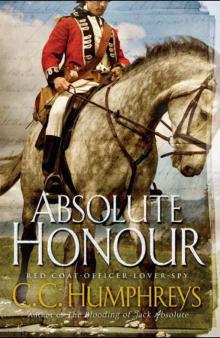 Absolute Honour
Absolute Honour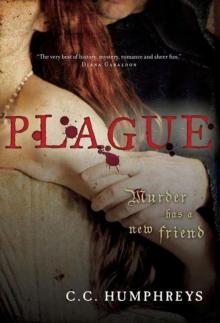 Plague
Plague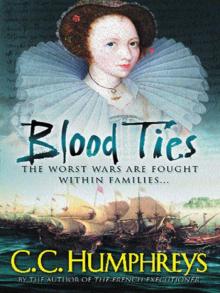 Blood Ties
Blood Ties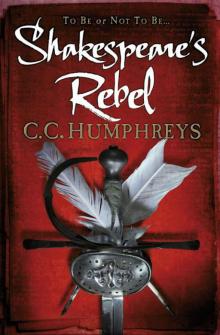 Shakespeare's Rebel
Shakespeare's Rebel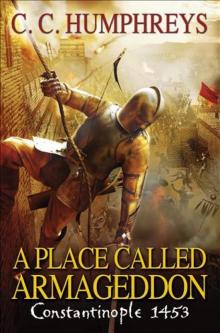 A Place Called Armageddon
A Place Called Armageddon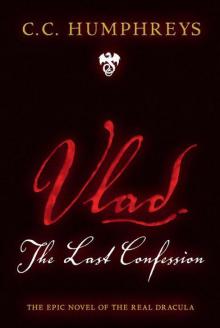 Vlad: The Last Confession
Vlad: The Last Confession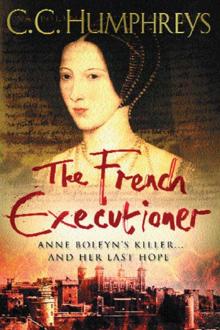 The French Executioner
The French Executioner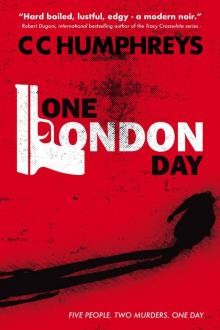 One London Day
One London Day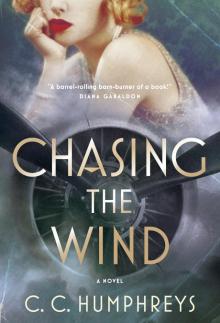 Chasing the Wind
Chasing the Wind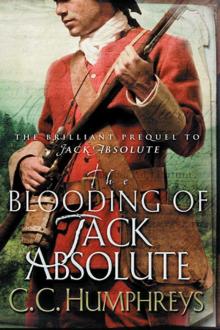 The Blooding of Jack Absolute
The Blooding of Jack Absolute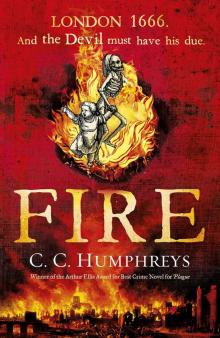 Fire
Fire